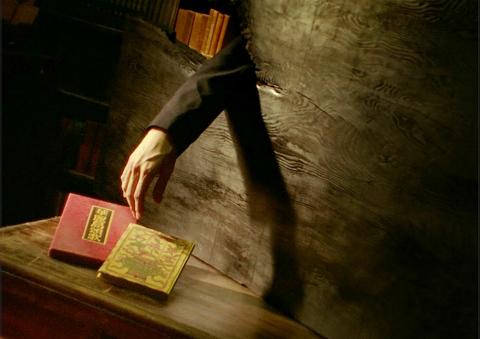Aesthetically speaking, Le Moulin (日曜日式散步者) is a beautiful, unique and creatively executed piece that captures the spirit of the surrealist French-influenced, Japanese-educated Taiwanese poets of the 1930s, an experimental documentary that meshes tastefully recreated scenes, evocative sequences, carefully selected details, poetry readings, historical photos and footage and text to create a multifaceted feature film that is almost like an extensive, epic ballad.
The film focuses on the Le Moulin Poetry Society, founded in 1935 by Yang Chih-chang (楊熾昌), Lee Chang-juei (李張瑞) and Lin Hsiu-er (林修二), who were proponents of French surrealism but wrote in Japanese, as many of the Taiwanese elite did at the time. Le Moulin only lasted a year, but the story follows the writers’ literary endeavors and correspondence up to the end of Japanese rule and the demise of their art form during the White Terror era.
The film’s driving narrative is the recreated scenes of these literary compatriots interacting with each other, carrying a loose focus on Lin as it delves into his home life and marriage. Few faces are shown, just hands, movement and voices, which is an inventive way to represent a past era. Notable publications are cleverly inserted into recreated scenes, and there’s also great deal of poetry, whether in text or through readings. There’s also plenty of historical found footage, providing background of the conflict on cultural, political and economic fronts during turbulent times.

Photo courtesy of atmovies.com
Here’s the problem though: there’s a reason why poetry is often short and sweet. The concept for the film is refreshing — but no movie without a comprehensible storyline, tension or memorable characters should be 162 minutes long. The first hour or so was enjoyable — and it should have ended there, but the film continued to mosey on at a snail-like pace without an end in sight.
There is ground to cover, as the story spans several decades. But like any film, it can be condensed, and probably should have been. There is too much crammed in here, as the “story” is bogged down by poetic and picturesque stylings that are delightful at first but become tiresome after a while. Even the ending simply wouldn’t end after the plot had already concluded, with atmospheric scene upon atmospheric scene leading to suffocation.
Perhaps it is not a surprise that director Huang Ya-li (黃亞歷), a young experimental filmmaker, had only produced short films before Le Moulin. His 2008 work The Pursuit of What Was (物的追尋), lasted only 22 minutes, and the 2010 The Unnamed (代以名之的事物) ran for an even shorter 11 minutes. The difficulty in transition from shorts to feature is obvious here for the aforementioned reasons.
Huang “discovered” the poetry society in Lin’s thesis while doing research on Taiwanese surrealism. After half a year of research and field study, he decided to put the film together.
Alas, this is the type of film that infallibly garners rave reviews at the international festival circuits, promoting local arthouse filmmakers to churn out more uncompromising films like Le Moulin. There is definitely an audience for this type of film, but with such a promising idea — especially one depicting such a little known slice of Taiwanese history — one would wonder if it could have been edited to be a bit more suitable for the general public. But then, would that be compromising the director’s artistic vision? After all, it’s not meant to be a mainstream film, and maybe that’s why high art and pop culture don’t often mix.

Oct. 27 to Nov. 2 Over a breakfast of soymilk and fried dough costing less than NT$400, seven officials and engineers agreed on a NT$400 million plan — unaware that it would mark the beginning of Taiwan’s semiconductor empire. It was a cold February morning in 1974. Gathered at the unassuming shop were Economics minister Sun Yun-hsuan (孫運璿), director-general of Transportation and Communications Kao Yu-shu (高玉樹), Industrial Technology Research Institute (ITRI) president Wang Chao-chen (王兆振), Telecommunications Laboratories director Kang Pao-huang (康寶煌), Executive Yuan secretary-general Fei Hua (費驊), director-general of Telecommunications Fang Hsien-chi (方賢齊) and Radio Corporation of America (RCA) Laboratories director Pan

The classic warmth of a good old-fashioned izakaya beckons you in, all cozy nooks and dark wood finishes, as tables order a third round and waiters sling tapas-sized bites and assorted — sometimes unidentifiable — skewered meats. But there’s a romantic hush about this Ximending (西門町) hotspot, with cocktails savored, plating elegant and never rushed and daters and diners lit by candlelight and chandelier. Each chair is mismatched and the assorted tables appear to be the fanciest picks from a nearby flea market. A naked sewing mannequin stands in a dimly lit corner, adorned with antique mirrors and draped foliage
The consensus on the Chinese Nationalist Party (KMT) chair race is that Cheng Li-wun (鄭麗文) ran a populist, ideological back-to-basics campaign and soundly defeated former Taipei mayor Hau Lung-bin (郝龍斌), the candidate backed by the big institutional players. Cheng tapped into a wave of popular enthusiasm within the KMT, while the institutional players’ get-out-the-vote abilities fell flat, suggesting their power has weakened significantly. Yet, a closer look at the race paints a more complicated picture, raising questions about some analysts’ conclusions, including my own. TURNOUT Here is a surprising statistic: Turnout was 130,678, or 39.46 percent of the 331,145 eligible party

The election of Cheng Li-wun (鄭麗文) as chair of the Chinese Nationalist Party (KMT) marked a triumphant return of pride in the “Chinese” in the party name. Cheng wants Taiwanese to be proud to call themselves Chinese again. The unambiguous winner was a return to the KMT ideology that formed in the early 2000s under then chairman Lien Chan (連戰) and president Ma Ying-jeou (馬英九) put into practice as far as he could, until ultimately thwarted by hundreds of thousands of protestors thronging the streets in what became known as the Sunflower movement in 2014. Cheng is an unambiguous Chinese ethnonationalist,